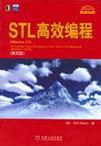STL高效编程
出版时间:2006-8 出版社:机械工业出版社 作者:迈耶斯 页数:260
Tag标签:无
内容概要
C++的标准模板库(STL)是革命性的,但是要想学会用好STL却充满了挑战性。中国台湾技术作家侯捷先生曾经把STL的学习过程比喻为三个境界: 第一境界:熟用STL。 第二境界:了解泛型技术的内涵与STL的学理乃至实作。 第三境界:扩充STL。 本书无疑是你达到第二境界的最佳读本。在本书中,C++技术权威Scott Meyers揭示了专家总结的一些关键规则,包括他们总是采用的做法以及总是避免的做法。这些规则可以发挥STL的最大效用。 有些书只是描述STL中有些什么内容,而本书则讲述如何使用STL。本书共有50条指导原则,在讲述每一条指导原则时,Scott Meyers都提供了透彻的分析和深刻的实例,所以读者不仅可以学到要做什么,而且还能够知道什么时候该这样做,以及为什么要这样做。 如同Meyers的其他著作一样,本书充满了从实践中总结出来的智慧。清晰、简明、透彻的风格使本书成为每一位STL程序员的案头必备。 本书特色 ●关于选择容器的建议,涉及的容器有:标准STL容器(例如vector和list)、非标准的STL容器(例如hash_set和hash_map),以及非STL容器(例如bitset)。 ●一些提高效率的技术,通过它们可以最大程度地提高STL(以及使用STL的程序)的效率。 ●深入到迭代器、函数对象和分配子(allocator)的行为,也包括程序员总是应该避免的做法。 ●对于那些同名的算法和成员函数,如find,根据它们行为方式上的微妙差异,本书给出了一些指导原则,以保证它们能被正确地使用。 ●讨论了潜在的移植性问题,包括避免这些移植性问题的各种简单途径。
作者简介
Scott Meyers,拥有布朗大学计算机科学博士学位,是世界顶级的C++软件开发技术权威之一。他的两本畅销书《Effective C++》和《More Effective C++》开创了技术图书“Effective”式的写作风格。他曾担行《C++ Report》杂志的专栏作家,还经常为《C/C++ Users Journal》和《Dr.
书籍目录
PrefaceAcknowledgmentsIntroductonChapter 1: Containers Item 1: Choose your containers with care. Item 2: Beware the illusion of container-independent code. Item 3: Make copying cheap and correct for objects in containers. Item 4: Call empty instead of checking size() against zero. Item 5: Prefer range member functions to their single-element counterparts. Item 6: Be alert for C++’s most vexing parse. Item 7: When using containers of newed pointers, remember to delete the pointers before the container is destroyed. Item 8: Never create containers of auto_ptrs. Item 9: Choose carefully among erasing options. Item 10: Be aware of allocator conventions and restrictions. Item 11: Understand the legitimate uses of custom allocators. Item 12: Have realistic expectations about the thread safety of STL containers. Chapter 2: vector and string Item 13: Prefer vector and string to dynamically allocated arrays. Item 14: Use reserve to avoid unnecessary reallocations. Item 15: Be aware of variations in string implementations. Item 16: Know how to pass vector and string data to legacy APIs. Item 17: Use “the swap trick” to trim excess capacity. Item 18: Avoid using vector. Chapter 3: Associative Containers Item 19: Understand the difference between equality and equivalence. Item 20: Specify comparison types for associative containers of pointers. Item 21: Always have comparison functions return false for equal values. Item 22: Avoid in-place key modification in set and multiset. Item 23: Consider replacing associative containers with sorted vectors. Item 24: Choose carefully between map::operator[] and map::insert when efficiency is important. Item 25: Familiarize yourself with the nonstandard hashed containers. Chapter 4: Iterators Item 26: Prefer iterator to const_iterator, reverse_iterator, and const_reverse_iterator. Item 27: Use distance and advance to convert const_iterators to iterators. Item 28: Understand how to use a reverse_iterator’s base iterator. Item 29: Consider istreambuf_iterators for character by character input. Chapter 5: Algorithms Item 30: Make sure destination ranges are big enough. Item 31: Know your sorting options. Item 32: Follow remove-like algorithms by erase if you really want to remove something. Item 33: Be wary of remove-like algorithms on containers of pointers. Item 34: Note which algorithms expect sorted ranges. Item 35: Implement simple case-insensitive string comparisons via mismatch or lexicographical_compare. Item 36: Understand the proper implementation of copy_if. Item 37: Use accumulate or for_each to summarize ranges. Chapter 6: Functors, Functor Classes, Functions, etc. Item 38: Design functor classes for pass-by-value. Item 39: Make predicates pure functions. Item 40: Make functor classes adaptable. Item 41: Understand the reasons for ptr_fun, mem_fun, and mem_fun_ref. Item 42: Make sure less means operator
图书封面
图书标签Tags
无
评论、评分、阅读与下载
用户评论 (总计6条)
- 阅读中,因为是英文版,所以读得要慢一点
- 这本书实用.
- 不过感觉没有第一本书名气大,不过如果经常用stl的话,应该好好看看
- 还算不错的一本书,不过送货的速度有待加强
- 内容很好,印刷很烂
- 学C++,还是C++Primer和C++ProgrammingLanguage
推荐图书
- 脂肪肝患者的家庭养护
- 养肝-归经食物养生坊I
- 慢阻肺患者健康生活
- 肿瘤科疾病健康读本
- 颈肩痛患者健康生活
- 内科疾病健康读本
- 外科疾病健康读本
- 传染科疾病健康读本
- 老年疾病健康读本
- Dreamweaver 8.0网页制作自学手册
- 善待心灵
- 八月の博物館
- 岸本斉史原画集
- 地球・精神分析記録
- levelup游戏城寨vol.4
- かめくん
- 画法几何及机械制图习题集
- 寒·十八禁
- levelup游戏城寨vol.3
- 吉里吉里人
- 木偶奇遇记-小学生世界儿童文学经典文库
- 尼尔斯骑鹅旅行记-小学生世界儿童文学经典文库
- 昆虫记-小学生世界儿童文学经典文库
- 小公主-小学生世界儿童文学经典文库
- 鲁滨逊漂流记-小学生世界儿童文学经典文库
相关图书
- DirectX特效游戏程序设计
- 汇编语言程序设计
- 五笔字词速查手册
- Office办公应用一点通
- Excel函数与图表一点通
- 中文版3ds max7基础培训教程
- Photoshop CS2基础培训教程-(中文版)(附光盘)
- WindowsXP操作应用培训教程
- 中文版Flash8动画制作培训教程
- 计算机组织与结构
- Series 40可扩展应用程序开发
- 中文版3ds max8基础与实例教程
- 电脑魔法学校
- Windows XP基础与提高
- Microsoft Windows XP系统应用案例教程
- Windows XP/2000/98 常见问题与故障1000例
- 电路分析
- 鲜花店店员手册
- 重症监护理论与实践(精) (精装)
- 胰腺病学(全2册) (精装)
- 威廉姆血液学(第5版) (精装)
- 肺脏介入医学 (平装)
- 质量技术监督基础教程
- 风湿病食疗汤水
- 浅谈肝炎防治
